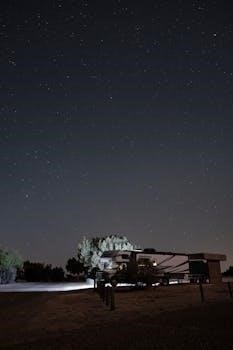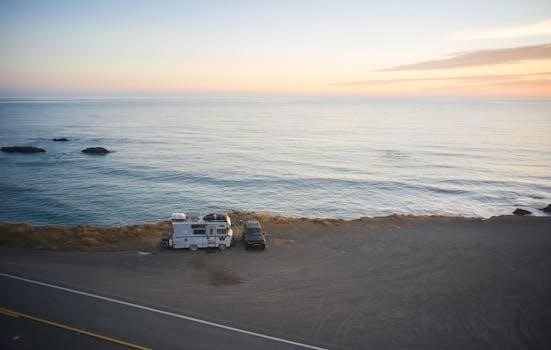
-
By:
- ophelia
- No comment
dometic rv ac unit manual
Okay, here is the generated text for the specified heading⁚

Dometic RV AC Unit Manual⁚ A Comprehensive Guide
Welcome to your comprehensive guide! This resource provides essential information, offering detailed instructions for operating and maintaining your Dometic RV AC unit. Maximize comfort and ensure longevity with our step-by-step guidance, covering troubleshooting, maintenance, and advanced features.
Dometic RV AC units are essential components for maintaining a comfortable environment inside recreational vehicles. These air conditioners are specifically designed to handle the unique challenges of RV environments, providing efficient cooling and climate control while on the road or at a campsite. Understanding the basics of Dometic AC units is crucial for effective operation and maintenance.
Dometic offers a range of AC models tailored to various RV sizes and power requirements. These units come in different profiles, including low-profile and high-profile designs, to accommodate different roof structures and aesthetic preferences. Selecting the right model ensures optimal cooling performance and energy efficiency;
Key features of Dometic RV AC units include robust construction, user-friendly controls, and advanced functionalities such as heat pump options and Bluetooth connectivity. Proper installation and regular maintenance are vital for prolonging the lifespan of these units and ensuring consistent performance. This guide will walk you through everything you need to know to keep your Dometic AC unit running smoothly, providing cool comfort wherever your travels take you.
Identifying Your Specific Dometic AC Unit Model
Identifying your specific Dometic AC unit model is the first crucial step in accessing the correct manual and troubleshooting information. Dometic manufactures various AC models tailored for different RV types and cooling needs. Locating the model number ensures you’re using the right resources for operation, maintenance, and repairs.
The model number is typically found on a sticker or nameplate affixed to the AC unit itself. This label is often located on the interior ceiling assembly (Air Distribution Box or ADB) or on the exterior unit mounted on the RV’s roof. Look for a series of numbers and letters, which uniquely identifies your specific model. Common locations include the underside of the unit’s cover or on a side panel.
Once you find the model number, make a note of it. This number will be essential for downloading the correct manual from the Dometic website or other online resources. Having the accurate model number will also help when ordering replacement parts or seeking technical support, ensuring compatibility and proper fit. Correct identification saves time and prevents potential issues down the line.

Locating and Accessing the Correct Manual
Once you’ve identified your Dometic AC unit model, locating the correct manual is essential for optimal operation and maintenance. Start by visiting the official Dometic website. Navigate to the “Support” or “Downloads” section, where you can typically search for manuals using your model number.
If the official website doesn’t yield results, try searching online using your model number followed by “manual” or “user guide.” Numerous third-party websites and RV forums may host archived manuals or offer links to downloadable versions. Ensure the source is reputable to avoid downloading incorrect or potentially harmful files.
Another valuable resource is the My RV Works website, offering service manuals acquired from part manufacturers. PDX RV also provides technical support and documentation, including wiring diagrams and specifications; Remember to check back often, as these sites frequently update their libraries.
When downloading, verify that the manual matches your specific model. PDF format is the most common and accessible. Save the manual to your computer or device for easy access, and consider printing a copy for convenient reference during maintenance or troubleshooting.

Understanding Basic Operation⁚ Thermostat and Controls
Understanding your Dometic RV AC unit’s thermostat and controls is crucial for effectively managing your RV’s climate. Familiarize yourself with the thermostat’s functions, including power on/off, temperature adjustment, and fan speed settings. Many Dometic thermostats offer multiple modes, such as “Cool,” “Heat,” and “Fan Only.” Select the appropriate mode based on your desired outcome.
The thermostat displays the current temperature and allows you to set your desired temperature. Experiment with different temperature settings to find your comfort zone. The fan speed control typically offers options like “Low,” “High,” and “Automatic.” “Automatic” mode adjusts the fan speed based on the difference between the current and set temperatures.
Some thermostats feature a digital display, while others use manual dials or buttons. Refer to your unit’s manual for specific instructions on using the controls. Pay attention to any indicator lights or error codes, as these can provide valuable information about the unit’s status. Dometic also offers Bluetooth-enabled capacitive touch thermostats, offering advanced control and monitoring capabilities.
Properly understanding and utilizing your thermostat and controls will ensure efficient operation and a comfortable RV environment.

Air Distribution Box (ADB) Overview and Manual Control
The Air Distribution Box (ADB) is a critical component of your Dometic RV AC system, responsible for channeling cool air throughout your RV. Typically mounted on the ceiling, the ADB features adjustable vents that allow you to direct airflow where it’s needed most. Understanding its function and manual controls enhances your climate management capabilities.
Most ADBs have a rotating dial or lever to control the airflow volume from each vent. Experiment with these controls to optimize comfort in different areas of your RV. In some models, you might find a central control that adjusts the overall airflow distribution. This allows you to prioritize cooling in specific zones.
Some ADBs also incorporate a manual on/off switch for the entire AC unit. This provides a convenient way to turn the system on or off without using the thermostat. Check your specific ADB model for these features. For non-ducted systems, a universal fit ADB with manual control can be used.
Properly adjusting the ADB vents ensures efficient cooling and prevents uncomfortable drafts. Regular cleaning of the ADB, as outlined in the maintenance section, will also maintain optimal performance.
Troubleshooting Common Issues⁚ A Step-by-Step Guide
Encountering issues with your Dometic RV AC unit can be frustrating, but many problems are easily resolved with a systematic approach. This section provides a step-by-step guide to troubleshoot common issues, helping you diagnose and fix problems quickly. Before starting, ensure your RV is safely connected to a reliable power source.
Begin by checking the basics⁚ Is the thermostat set correctly? Are the circuit breakers tripped? Next, inspect the air filter. A dirty filter restricts airflow, causing the unit to overheat and perform poorly. Clean or replace the filter as needed.
If the AC unit is running but not cooling effectively, examine the condenser coils for dirt and debris. Clean the coils gently with a soft brush or vacuum; Low refrigerant can also cause poor cooling; consult a qualified technician for refrigerant recharge.
For unusual noises, inspect the fan blades for obstructions or damage. If the fan motor is failing, it may need replacement. If these steps don’t resolve the issue, consult a qualified RV technician or refer to the warranty information for support.
Maintenance Procedures⁚ Cleaning and Filter Replacement
Regular maintenance is crucial for maximizing the lifespan and efficiency of your Dometic RV AC unit. This section details essential cleaning and filter replacement procedures. These simple tasks can prevent costly repairs and ensure optimal performance. Always disconnect power to the AC unit before performing any maintenance.
Start with the air filter, typically located in the interior air distribution box (ADB). Remove the filter cover and slide out the filter. Clean the filter with mild soap and water, or replace it with a new filter if heavily soiled; Allow the filter to dry completely before reinstallation.
Next, clean the exterior condenser coils. These coils dissipate heat and can become clogged with dirt and debris. Use a soft brush or vacuum with a brush attachment to gently remove any buildup. Avoid using high-pressure water, as it can damage the coils.
Inspect the ADB vents and clean them with a damp cloth to remove dust and grime. Regularly check for any signs of leaks or damage around the AC unit and address them promptly to prevent further issues.
Electrical Considerations⁚ Power Requirements and Safety
Understanding the electrical requirements of your Dometic RV AC unit is essential for safe and efficient operation. This section outlines the power needs and crucial safety precautions. Always consult the unit’s manual for precise specifications related to your specific model. Overloading circuits can lead to overheating and potential fire hazards.
Dometic RV AC units typically require a dedicated 120V AC power supply. Ensure your RV’s electrical system can handle the unit’s amperage draw, often around 10-15 amps. When using a generator, verify it provides sufficient wattage and a stable voltage output. Using an undersized generator can damage the AC unit.
Regularly inspect the power cord for any signs of damage, such as cracks or fraying. Replace damaged cords immediately. When connecting to shore power, use a properly grounded extension cord of the correct gauge. Never use multiple extension cords linked together.
Before performing any electrical work, disconnect the power source. If you are unfamiliar with electrical systems, consult a qualified electrician to avoid potential hazards. Prioritize safety when dealing with electricity.
Advanced Features⁚ Heat Pump and Bluetooth Connectivity
Many modern Dometic RV AC units boast advanced features that enhance comfort and convenience. Two popular options are the integrated heat pump and Bluetooth connectivity. Heat pumps provide efficient heating in moderate temperatures, extending the usability of your RV in cooler climates. Bluetooth connectivity allows you to control your AC unit remotely via a smartphone app.
The heat pump function operates by reversing the cooling process, extracting heat from the outside air and transferring it inside. This is more energy-efficient than traditional electric resistance heating, especially when outdoor temperatures are above 40°F (4°C). Consult your manual for optimal heat pump operating ranges and performance tips.
Bluetooth-enabled Dometic AC units offer seamless control through a dedicated mobile app. This app allows you to adjust temperature settings, fan speeds, and operating modes from the convenience of your smartphone or tablet. Some apps also provide diagnostic information and error code displays, simplifying troubleshooting.
Refer to your unit’s manual for specific instructions on pairing your device and utilizing all the app’s features. Ensure your smart device is within Bluetooth range of the AC unit for reliable connectivity. Explore the app’s settings to customize your comfort preferences.
Finding Replacement Parts and Accessories
Maintaining your Dometic RV AC unit often requires replacing worn or damaged parts. Fortunately, a wide range of replacement parts and accessories are available to keep your unit running smoothly. Begin by identifying the specific model number of your AC unit; this information is crucial for ensuring compatibility with replacement parts.
Dometic offers a comprehensive catalog of parts, including filters, fan motors, capacitors, control boards, and air distribution components. You can find these parts through authorized Dometic dealers, RV supply stores, and online retailers. When purchasing online, verify the seller’s credibility and ensure the parts are genuine Dometic products to guarantee quality and proper fit.
Accessories can also enhance your AC unit’s performance and convenience. Consider adding a soft start capacitor to reduce the initial power surge during startup, which is particularly useful when operating on generator power. Air distribution boxes with adjustable vents can improve airflow and temperature control throughout your RV.
Before ordering any parts or accessories, consult your Dometic RV AC unit manual for a complete list of compatible components and installation guidelines. Proper installation is essential to avoid damage and ensure optimal performance. If you are unsure about any repair or installation procedure, seek assistance from a qualified RV technician.
Warranty Information and Support Resources
Understanding your Dometic RV AC unit’s warranty is crucial for protecting your investment and accessing support when needed. Dometic provides a limited warranty on its AC units, typically covering defects in materials and workmanship for a specific period. The warranty period and coverage details can vary depending on the model and purchase date, so carefully review your warranty documentation.
Keep your purchase receipt and warranty card in a safe place, as you will need them to make a claim. Before seeking warranty service, consult the troubleshooting section of your owner’s manual to see if you can resolve the issue yourself. If the problem persists, contact an authorized Dometic service center.
Dometic’s website offers a wealth of support resources, including FAQs, troubleshooting guides, and product manuals. You can also contact Dometic’s customer service department via phone or email for assistance. When contacting support, be prepared to provide your unit’s model number, serial number, and a detailed description of the problem.
In addition to Dometic’s resources, numerous online forums and RV communities can provide valuable information and support. Sharing experiences with other RV owners can help you troubleshoot issues and find solutions. However, always verify the accuracy of information from unofficial sources and consult with qualified technicians when necessary.